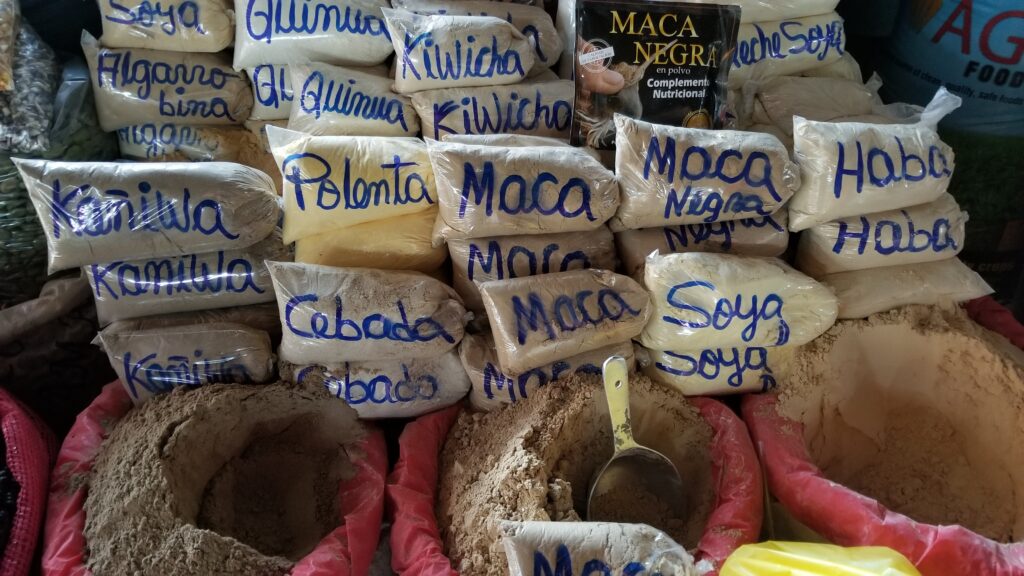Written By: Nicole Berry, MS in Holistic Nutrition. Nicole designed our Nutrition and Natural Medicine program in Peru.

Abstract
Maca, Lepidium meyenii or Lepidium peruvianum, has been praised for its nutritional and medicinal benefits for centuries. Scientific studies have shown solid evidence to back up the traditional belief in maca’s health powers. Studies show that maca consumption prevents and combats disease, improves sexual health, and provides rich nutritional content. Furthermore, maca has been shown to increase energy, physical performance and sexual desire in both men and women. The ailments which maca has shown to effectively treat include flu A, flu B, metabolic disorder, osteoporosis, anemia, erectile dysfunction, infertility, menopausal symptoms, malnutrition, fatigue, chronic inflammation, memory loss, chronic fatigue, depression, anxiety, sterility, lack of libido, menopausal symptoms, menstrual symptoms, stomach cancer, stress tension, tuberculosis, benign prostatic hyperplasia and altitude sickness. The objective of this paper is to evaluate whether the consumption of maca improves human health and in what ways.
Introduction
Maca root has been cultivated in the high Peruvian Andes for about 2,600 years. Growing between 2,700 to 4,300 meters above sea level, maca is the highest-altitude crop grown on Earth (Wolfe, 2010). Maca is a member of the cruciferous family of vegetables. Traditionally, maca root has been used to increase sexual activity and boost stamina. Maca provides a variety of medicinal and nutritional health benefits such as increased energy, hormonal balance in the body, decreased menopausal hot flashes, decreased menopausal vaginal dryness, increased libido, decreased incidence of osteoporosis and prevention of memory loss. Nutritionally, maca contains magnesium, calcium, zinc, iron, and an array of vitamins (K. Bajwa, J. Bajwa, & Singh, 2012). Ley (2003) also reported that maca provides three major benefits: a hormone balancer and regulator, an adaptogen supporting the endocrine system especially the adrenal glands, a reduction in the effects of stress, a sexual stimulant and a fertility aid. The objective of this paper is to evaluate whether the consumption of maca improves human health and in what ways.

Results
A number of studies completed on maca have shown that it is an adaptogen which means that it helps stabilize the body’s glandular-hormonal, nervous, cardiovascular and musculature systems. Adaptogens are nontoxic, improve homeostasis in the body and produce an adaptive response to stress. Research has also shown that maca is known to improve anemia, chronic fatigue, depression, infertility, sterility, lack of libido, malnutrition, menopausal symptoms, menstrual discomfort and disorders, poor memory, stomach cancer, stress tension, and tuberculosis (Wolfe, 2010).

Health Benefits
Women who had menstrual irregularities reported greater consistency while using maca. Menopausal women who struggled with hot flashes, mood swings and other perimenopause and menopausal symptoms showed significant decreases in these symptoms while consuming maca (Ley, 2003).
By increasing the blood oxygen content, maca helps the body deal with the environmental stress of altitude sickness. Maca has also shown to provide the body with more energy when needed, without overstimulating when it is not needed. Like other adaptogens, maca improves the body’s ability to adapt to stress (Wolfe, 2010).
Chacon, a Peruvian biologist who has performed extensive research on maca, theorized that maca activates endocrine glands which increases energy, vitality and libido. Researchers, including Chacon, consider plant sterols, isothiocyanates, macamides and glucosinolates to be the constituents of maca which enhance fertility and libido (Sifuentes-Penagos, León-Vásquez, & Paucar-Menacho, 2015). Additional studies have shown that consuming maca had a positive effect on physical capacity and the immune system (Sifuentes-Penagos et. al, 2015).
Maca has anti-viral, anti-cancer, anti-inflammatory, antioxidant, anti-pathogenic, and free-radical fighting properties which make it a potent disease prevention tool. As an adaptogen, maca has the ability to balance and stabilize the glandular-hormonal, nervous, endocrine, cardiovascular and musculature systems. This makes maca an excellent treatment for battling physical, chemical or biological stressors (Wolfe, 2010).
Nutrition Facts
Maca is commonly purchased in dried powder form (Rondan-Sanabria, Pires, & Finardi Filho, 2006). Nutritionally, dried maca contains 247g calcium, 14.7mg iron, and 183mg phosphorous, per 100g (Sifuentes-Penagos et al., 2015). Maca consists of up to 59% carbohydrates, 10-14% protein, 8.5% fiber, 2.2% lipids and is also rich is starch, glucosides,
alkaloids and tannins (Flores, Walker, Guimarães, Vivanco, & Pal Bais, 2003). This protein is made up of 18 to 19 amino acids, 7 of which are essential amino acids, in maca (SifuentesPenagos et al., 2015). Maca also contains 2.2 percent lipid fats including linolenic acid, palmitic acid, and oleic acid as the primary fatty acids. It also contains immune-enhancing sterols like sitoserol, campesterol, ergosterol, brassicasterol, and ergostadienol. The aphrodisiac properties of maca come from the isothiocyanates, especially p-mehtoxybenzyl isothiocyanate. In terms of
minerals, maca is rich in calcium, magnesium, phosphorous, potassium, sulfur, sodium, and iron and contains trace minerals like zinc, iodine, copper, selenium, bismuth, manganese, tin and silicon. The vitamins include B1, B2, C and E (Wolfe, 2010). Maca is regarded as a superfood
due to its rich nutritional content.
Discussion
Current research suggests that incorporating maca into the human diet has a positive impact on health both medicinally and nutritionally. There are thirteen varieties of maca ranging in color from white to black. Research also shows that the nutrient content and health effects vary slightly based on the color of the maca and even more on the soil the maca was grown in. For example, red maca reverses benign prostatic hyperplasia and experimentally induced osteoporosis. Black maca has the best results on spermatogenesis, memory and fatigue. Other areas of health which maca impacts include malnutrition, disease prevention, sexual and reproductive function, anxiety, depression, metabolic disorder, mental and physical energy, anemia, menopausal symptoms, tuberculosis and stress tension (Gonzales, Villaorduña, Gasco, Rubio, & Gonzales, 2014).
A variety of studies show that consuming maca prevents disease. This is partly because of the anti-viral, anti-cancer, and anti-pathogenic properties of maca. Scientists have found that the glycosylates in maca have anti-carcinogenic and anti-pathogenic properties (SifuentesPenagos et al., 2015). Studies have also shown that maca is a very effective treatment against both Flu A and Flu B viruses (Del Valle Mendoza, Pumarola, Gonzales, & del Valle, 2014). The sterols in maca have been shown to help reduce cholesterol, prevent menopausal symptoms, and improve fertility. These sterols also contain anti-inflammatory and antioxidant properties. Maca has been shown to be a great energizer, anti-oxidant, and to eliminate free radicals. Maca contains phytochemicals which help to reduce chronic inflammation (Sifuentes-Penagos et al., 2015). Maca is a superfood and an adaptogen. Adaptogens have the ability to balance and stabilize the glandular-hormonal, nervous, endocrine, cardiovascular and musculature systems. This makes maca an excellent treatment for battling physical, chemical or biological stressors (Wolfe, 2010).
Chemical analysis shows that maca contains fertility-enhancing properties (Flores et al., 2003). Though it has not yet been proven in humans, studies on rats have shown increased in fertility and sperm count as a result of maca consumption. In addition to the studies conducted on
rats, a smaller study was conducted on nine men which showed a significant increase in sperm production and erectile function (Sifuentes-Penagos et al., 2015). Black maca shows the most significant impact on sperm count, with yellow maca coming in second place. By contrast, red
maca had no effect on sperm count. Studies conducted on male athletes have shown a significant effect of maca on erectile dysfunction as well as increased sexual desire. Two clinical studies on healthy menopausal women also showed increased sexual desire (Gonzales et al., 2014). While
studies show promise for the use of maca to improve sexual desire, more research is needed.
Human studies show that maca reduces depression and anxiety in otherwise healthy adult men. In postmenopausal women, consumption of maca for six weeks at 3.5g per day decreased psychological symptoms including anxiety and depression (Gonzales et al., 2014). Studies have
shown that maca is more effective than the placebo in combating menopausal symptoms; however, more studies are needed to fully prove that maca is an effective menopausal treatment (Sifuentes-Penagos et al., 2015).
Maca is a promising treatment for metabolic syndrome. Metabolic syndrome is a cluster of conditions including high blood pressure, high fasting blood sugar, low HDL cholesterol, high triglyceride levels, and a large waistline (‘What is metabolic syndrome?’, 2016). Black maca extract reduced 50% of the blood glucose in diabetes-induced male rats. Yellow maca, decreases the glycemia and increases insulin levels in diabetes-induced rats. Maca also improves the lipid profile and increased glucose tolerance in animals with hypertriglyceridemia. A clinical study conducted on men treated with gelatinized maca showed a decrease in diastolic pressure after 12 weeks of treatment. Populations of people who consume maca traditionally, have lower systolic pressure than those who do not consume maca (Gonzales et al., 2014).
Increased physical capacity has been shown with maca consumption. A two-week study conducted on eight cyclists showed increased sexual desire and improved racing times. Increased sexual desire was also shown in a study conducted on 56 men between the ages of 21 to 56 years
old. Sexual desire increased by 42.2% during a 12 week maca treatment study (SifuentesPenagos et al., 2015). Another study conducted on ten professional soccer players demonstrated a 10.3% increase in oxygen consumption after consuming maca (Gonzales et al., 2014). Maca has been shown to be a powerful energizer well indicated for malnutrition or stress given that it improves both physical and mental energy (Del Valle Mendoza et al., 2014).
In studies conducted on male rats, red maca proved to be an effective treatment for reversing benign prostatic hyperplasia. More studies are needed to prove that this could be effective in humans. Because nearly half of men over 40 have this condition, it would be impactful to find a natural treatment in red maca (Gonzales et al., 2014).
Both red and black maca have also been shown to have a similar effect on osteoporosis as estradiol (Gonzales et al., 2014). The benefits of maca for treating osteoporosis. Experimental studies show that maca may be promising to assist with the treatment of osteoporosis; however, more clinical studies are needed to further support this (Gonzales et al., 2014).
In conclusion, maca is a powerful superfood which can help combat malnutrition, a variety of disease and provides an array of health benefits. Incorporating maca into the human diet will improve vitality and overall health for both men and women.
Conclusions and Recommendations
Consuming maca on a regular basis improves overall health. Maca is known as a potent superfood which helps to prevent disease and improve nutrition among other health benefits. Because of its rich nutrient content, maca is a powerful tool to combat malnutrition. Scientific evidence shows positive effects on sexual health, depression, anxiety, mood, memory,
osteoporosis, fatigue, metabolic disorder, menopausal symptoms, tuberculosis, stress tension and the treatment of some tumors. Many studies show that maca contributes to sexual health in the areas of reproductive health, erectile dysfunction, sexual desire, spermatogenesis and fertility. Maca is also a powerful mental and physical energizer.
While a significant amount of encouraging research is available on the various health benefits of maca, there are a few areas which warrant further study. For example, improved sexual function including fertility enhancement, erectile function and increased sperm count. Additionally, more studies are also needed to prove that maca is an effective treatment for menopause symptoms, osteoporosis, and reversing benign prostatic hyperplasia.
Some studies refer to maca by its scientific name Lepidium meyenii. Others state that maca may alternatively be called Lepidium peruvianum. In actuality, Lepidium peruvianum refers to a specific type of Lepidium meyenii which grows between 4,100 to 4,300 meters above sea level in the departments of Pasco an Junin, Peru (Chacon de Popovici, 1990). The lack of differentiation across studies should be clarified to avoid overgeneralization of results among types of maca. More research exists to support maca’s effects on sexual function than its effects on memory, mood and overall health (Wolfe, 2010). Further research should be conducted on the health benefits of maca.
References
Chacon de Popovici, G. (1990). La Maca (Lepidium peruvianum Chacón sp. Nov.) y su habitat. Revista Peruana de Biología, 3(2), 171–267. doi:10.15381/rpb.v3i2.8305
Del Valle Mendoza, J., Pumarola, T., Gonzales, L. A., & del Valle, L. J. (2014). Antiviral activity of maca (Lepidium meyenii) against human influenza virus. Asian Pacific Journal of Tropical Medicine, 7, 415–420. doi:10.1016/S1995-7645(14)60268-6
Flores, H., Walker, T., Guimarães, R., Vivanco, J., & Pal Bais, H. (2003). Andean Root and Tuber Crops: Underground Rainbows. HortScience, 38(2), 163–`166.
Gonzales, G., Villaorduña, L., Gasco, M., Rubio, J., & Gonzales, C. (2014). Maca (Lepidium meyenii Walp), una revisión sobre sus propiedades biológicas. Revista Peruana de Medicina Experimental y Salud Publica, 31(1), 100–110. Retrieved from
http://www.scielo.org.pe/scielo.php?script=sci_arttext&pid=S1726-46342014000100015
Kaur Bajwa, S., Jit Singh Bajwa, S., & Singh, A. (2012). Nutritional facts and menopausal symptomatology: The role of nutraceuticals. Journal of Medical Nutrition and Nutraceuticals, 1(1), 42–49. doi:10.4103/2278-019X.94633
Ley, B. M. (2003). Maca!: Peruvian ginseng– the hormonal regulator. Detroit Lakes, MN: BL Publications,U.S.
Rondan-Sanabria, G. G., Pires, T. da C. R., & Finardi Filho, F. (2006). Preliminary approach to detect amylolytic and pectinolytic activities from maca (Lepidium meyenii Walp.). Revista Brasileira de Ciências Farmacêuticas, 42(1), . doi:10.1590/s1516-93322006000100005
Sifuentes-Penagos, G., León-Vásquez, S., & Paucar-Menacho, L. M. (2015). Study of Maca (Lepidium meyenii Walp.), Andean crop with therapeutic properties. Scientia agropecuaria, 6(2), 131–140. doi: 10.17268/sci.agropecu.2015.02.06
What is metabolic syndrome? (2016, June 22). Retrieved July 22, 2016, from NHLBI, NIH, http://www.nhlbi.nih.gov/health/health-topics/topics/ms
Wolfe, D. (2010). Superfoods: The food and medicine of the future. Berkeley, California: North Atlantic Books

